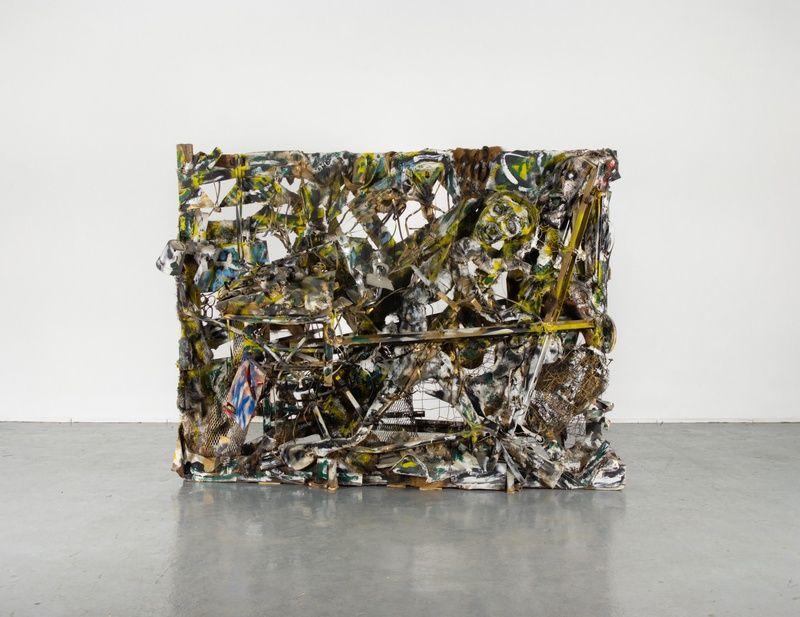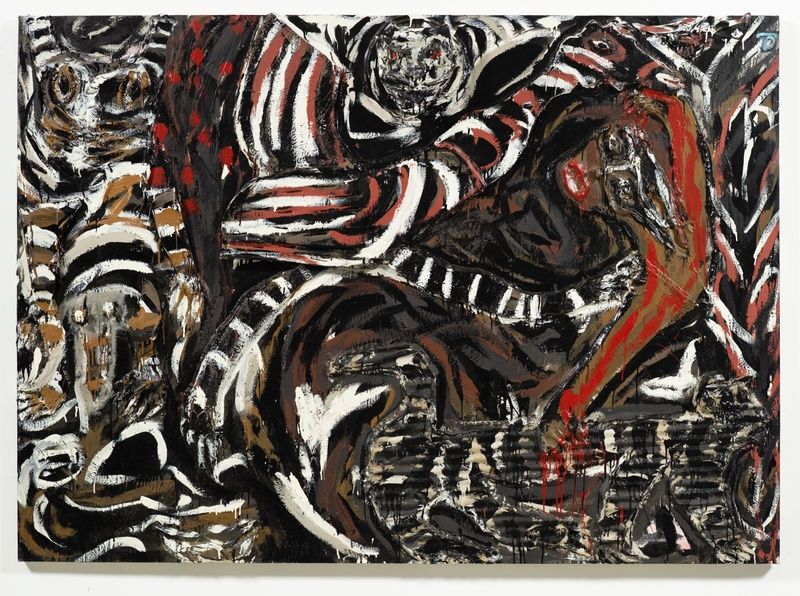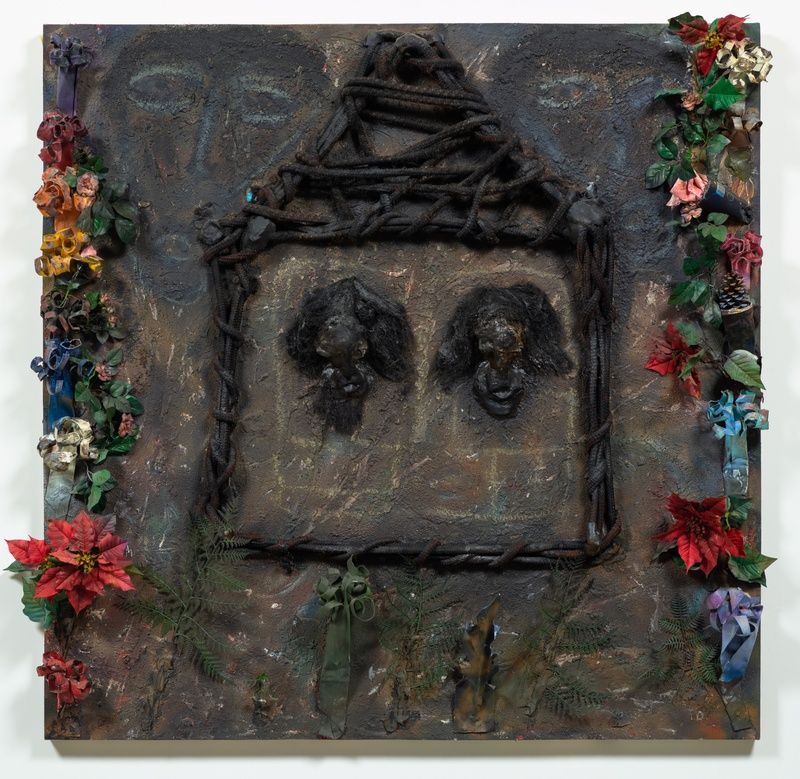James Fuentes Gallery
Thornton Dial
Paintings: 1990-1998
"Art is future life, and I try to match up colors that fit that life. Art supposed to show the way the world is: sometimes dark, sometimes light. A piece of art is like the movement of the clouds, or the sun in the sky, like the works of the United States go, constant moving, always changing.”—Thornton Dial
The work of Thornton Dial (1928–2016) delivers a deeply personal historical account of life in the United States. Born and raised in rural Alabama on a sharecropping farm, from a young age Dial would collect discarded and recycled materials to be worked into new objects, and meanwhile observed deep physical and philosophical lessons from his decades of experience working different jobs, including thirty years as a metalworker at the Pullman-Standard Company manufacturing railroad cars. Over time, Dial developed a highly sophisticated artistic vernacular and expressionistic mode that blurred the boundaries between painting and sculpture as disciplines, and came to truly compete with the avant-garde. Dial’s artistic career was marked by his first exhibition of note, Ladies of the United States, presented in Atlanta in 1990 and well-received by audiences. Upon reflection, decades after this first show, Dial stated: ”I believe I have proved that my art is about ideas, and about life, and the experience of the world. I have tried to learn how to explain everything I have did. I tried to name everything that could be named about that experience, and if a person still see ignorance in me, he might just be looking into his own self.” Returning to this early period of Dial’s output, the works on view span the decade of the 1990s, prompting striking connections between their powerful material presence when encountered today and their larger cultural, art historical, and symbolic reverberations.
Alongside five major wall-based works, Dial’s freestanding Banded Up for Safety forms part of the exhibition’s architecture. Viewed in-the-round, this large-scale work is particularly unique and significant within Dial’s oeuvre. Constructed of paint, tin, fiberglass, carpet, burlap, rope, and modeling compound, among other gathered materials, each mixed-media assemblage on view presents an intensely textured vision that also carries within it key symbols and larger narratives that run throughout the artist’s long career, often further indicated by the titles of each piece. The works on view often share references to biblical allegory. For example, Adam and Eve, the First to Come (Looking for the Garden) (1997) conveys not only the titular biblical couple, but does so in order to imagine the very first couple of the American slave community. The scene is situated in a plantation slave cabin, surrounded by a garden configured of artificial flowers—describing the abrasive quality even of shelter and the natural landscape in this time and place, yet also surrounded by the two floating figures of ancestors who look on from above. Moses/ Bondage (1993) also uses biblical analogy to envision the mythology of passage through the image of Moses parting the Red Sea. Symbolically, Moses stands as a deeply important emancipatory figure in Black Christianity, depicted here to simultaneously describe the threshold between the figure in bondage as well the escape from bondage. The particularly monochromatic appearance of this work is unique
within Dial’s practice—as he observed, “You can make a lot of different colors only with black.”
The earliest work in the exhibition, The Longest Tiger in the United States (1990) points to the recurring symbol of the tiger in Dial’s work, which he considered to be a stand-in for himself, and likewise as a powerful representation of the Black renaissance man. The word “long” similarly reappears in many of Dial’s titles as an analogy for potency and virility, as depicted in this work. In Around the World with the Long-Stepping Bird (1992), three more tigers appear (the central, uppermost figure being a self-portrait of Dial), while a female figure with long, free-flowing hair dominates much of the canvas. With this work, Dial sought to complicate various superficial features that communicate fertility and dominance between men and women, while the phrase “around the world” indicates the universality of this condition in life across borders and ethnicities. Hard Labor (1998) adopts a universal symbol of another kind through the pail, representing this vessel through which almost everything occurred in the tradition of a still-life, a rare choice for Dial. For the artist, the pail was an important symbol of struggle, as it was the object used for all labor, from laundry to fieldwork. Set within a pastoral scene, Dial elevates the object as symbolically beautiful and powerful as well, carrying a double-edged meaning as both a tool and a source of pride. More broadly, the work also speaks to way in which Dial would often be inspired by chance encounters in daily life, which would then appear like snapshots within his works (on one of his many walks in Bessemer, Dial came across a pail sitting in a garden, much like the image in this work).
Finally, we return to Banded Up for Safety (1994), which relies upon bed frames as the core structure for this extraordinarily sculptural work. Here, Dial adopts the bed as universally symbolic of refuge: the place where one can ultimately return at the end of the day to rest their head, no matter how profound the difficulties of the daytime. In this work, the bed also becomes a physical repository for the many objects in Dial’s orbit, from the materials of his art studio, like paint lids and spray bottles, to those of farming labor, like the hoe—once again producing double meanings in order to speak to the historical and lived complexity of bondage, refuge, and emancipation.
Concurrently on view are works on paper from the same decade, presented from June 17–July 16 through
JamesFuentes.Online in collaboration with The William Louis-Dreyfus Foundation and Family Collections.
Thornton Dial (b. 1928 Emelle, Alabama; d. 2016 McCalla, Alabama) has presented solo exhibitions at the Museum of Fine Arts, Houston; High Museum of Art, Atlanta; New Orleans Museum of Art, New Orleans; New Museum, New York; and has been included in group exhibitions at The Metropolitan Museum of Art, New York; de Young Museum, San Francisco; The Birmingham Museum of Art, Birmingham; Brooklyn Museum, New York; The Studio Museum in Harlem, New York; Hirshhorn Museum and Sculpture Garden, Smithsonian Institution, Washington, DC; and the 2000 Whitney Biennial. Solo exhibitions at galleries including Andrew Edlin (2014, 2012, 2011), Marianne Boesky (2016, 2015), and David Lewis (2020, 2018). In 2012 James Fuentes presented a two-person exhibition pairing Lizzi Bougatsos with Thornton Dial. Dial’s work is included in the collections of the Metropolitan Museum, Museum of Modern Art, Whitney Museum, Brooklyn Museum, Studio Museum, Smithsonian American Art Museum, de Young Museum, Hirshhorn Museum, Philadelphia Museum of Art, Minneapolis Institute of Art, Harvard Art Museums, among others.
The William Louis-Dreyfus Foundation has been established as an educational resource to promote public awareness of the works of self-taught, contemporary and emerging artists. The foundation also intends to benefit other specific educational purposes when it sells its artwork, in particular the educational programs of the Harlem Children’s Zone. Over 200 artists are in its collection of more than 3,500 works of art that are housed in museum-quality space in Mount Kisco, New York. The foundation currently offers online presentations and virtual tours and looks forward to reopening to the public in the fall with tours scheduled by appointment. For more information, please visit the foundation’s website: wldfoundation.org
Works

Hard Labor, 1998
Initialed top right recto
Carpet, rope, metal, fabric, industrial modeling compound and paint on plywood
48 × 48 × 3 inches

Banded Up for Safety, 1994
Mixed media construction with metal framework
74 × 96 × 24 inches

Around the World with the Long-Stepping Bird, 1992
Initialed top right recto
Mixed media with paint on canvas mounted on board
66 × 92 × 6 inches

Adam and Eve, the First to Come (Looking for the Garden), 1997
Initialed recto bottom right corner
Enamel and mixed media on canvas mounted on wood
62 × 62 × 9 inches